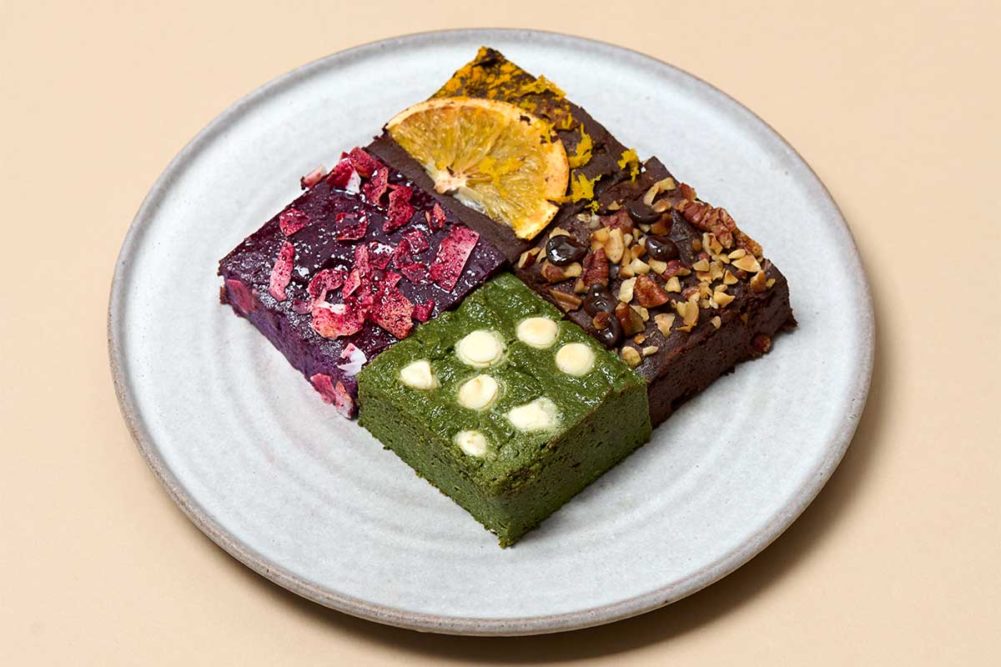Water makes up 17% to 25% of cakes and muffins, but most consumers would never know it because the water in properly formulated baked goods is bound. Without this water, these products would be stale and crumbly.
At the same time, if there’s too much water, or it’s not in a bound molecular arrangement, the baked goods are soggy and prone to mold growth. Managing moisture is paramount for quality and safety. That’s where hydrocolloids come in.
“Hydrocolloids absorb and hold large quantities of water, which make the batter more viscous,” said Becky Regan, principal designer, bakery, fats and oils, IFF. “This helps the batter trap and hold more air during mixing. It also helps particulates, such as chocolate bits, raisins, etc., remain suspended throughout the batter and not sink to the bottom.”
Hydrocolloids also reduce air cell coalescence, which is when smaller air bubbles combine to make large bubbles, and bubble loss in thicker batters during bench time and early baking, creating a tighter, more uniform crumb, she said.
“Most hydrocolloids used in cakes and muffins impart a pseudoplastic rheology to the batter,” Ms. Regan continued. “This phenomenon — also known as shear thinning — means the batter becomes less viscous as the batter is pumped and deposited, but then the thick viscosity returns after the batter is in the baking pan.”
To appreciate the use of hydrocolloids in cakes and muffins, one must understand the role of water. For starters, the water that gets added to batters is known as bulk water, or water that comes from a spigot.
Water is also present in various other cake ingredients. Some may be chemically bonded to other molecules, such as salt or sugar. These bonds can be very strong.
There’s also capillary water, which is trapped moisture held in narrow channels between certain food components. Think of it as water surrounded by a physical barrier that prevents it from easily escaping, such as the water in blueberry skin. This type of water tends to have physicochemical properties similar to that of bulk water.
Bulk water on its own or in other ingredients may become physically bound through the addition of hydrocolloids. Many are polysaccharides, such as fibers, starches and gums. However, some proteins, such as gelatin, as well as specialty proteins derived from eggs and milk, are considered hydrocolloids. Their primary function is thickening or gelation, while secondary functions include aeration, emulsification, encapsulation and suspension. When these food constituents bind with water, they create a system that no longer recognizes the water as free bulk water.
Food manufacturers might be tempted to include as much water as possible into baked goods because water is a “free” ingredient in terms of cost, calories and nutrition, but bakers must know their limits.
“Increased viscosity, batter stabilization and pseudoplastic rheology contribute to a larger volume,” Ms. Regan said. “The impact of this could be a larger-sized baked product and/or it could mean cost savings because less batter is required to make a given-sized baked product, resulting in more units per batter.”
Bound water may also assist with fat and sugar reduction. In gluten-free cakes and muffins, bound moisture assists with textural improvements.
“The water-holding properties and effects on texture and mouthfeel of certain hydrocolloids alone or in combination with other functional ingredients can mimic the functionality and eating properties of fat, sugar and gluten in some baked products,” Ms. Regan said.
Sustainable structure and air distribution can also aid in the structural integrity of a baked product.
“Hydrocolloids provide support in the batter by preventing excessive spreading, collapsing or the formation of large air pockets during baking,” said Wei Li, director of texture solutions, ADM. “Sustaining structure and air distribution can deliver a more uniform texture and enhance the structural integrity of the baked good, helping them rise evenly and prevent collapse.”
Another reason to use hydrocolloids in cakes and muffins is to provide freeze/thaw stability, said Kara Selgrade, senior manager, business development for food systems, Ingredion Inc. This stability is important not only in baked goods, but in fillings and toppings.
“Hydrocolloids help prevent boil-out in bake-stable fillings and improve freeze/thaw stability,” she said. “In icings, frostings and glazes, gums help prevent transfer onto packaging and prevent cracking of glazes and sugar bloom.”
Mary Galloway, application scientist, Meters Group Inc. USA, said bakers need to remember that the amount of moisture in a product also influences nutritional content and labeling. Formulations need to be consistent and water content understood.
“The water content of food is expressed as a percent; however, this number does not reflect how the water exists in the food. Formulators must consider all four forms of water — bulk, capillary, physically bound and chemically bound — when trying to manage moisture. This takes into consideration water activity, which indicates how tightly water is bound in a food matrix.”
Why does this matter? Water activity predicts safety and stability with respect to microbial growth, chemical and biochemical reaction rates, and various physical properties.
“If you understand how water activity works, you will be able to develop products that are stable and desirable to the consumer and can predict and prevent potential problems,” Ms. Galloway said. “There is a relationship between water activity and moisture content, but it is unique to each product and formulation. Differences in water activity dictate how water will move, for example, between components in a food matrix, between microorganisms and a food matrix, etc.”
This article is an excerpt from the October 2023 issue of Baking & Snack. To read the entire feature on Gums & Texture, click here.





